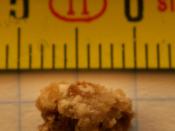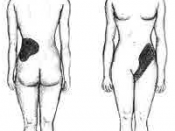Kidney stones, one of the most painful of the urologic disorders, are not a product of modern life. Scientists have found evidence of kidney stones in a 7,000-year-old Egyptian mummy. Unfortunately, kidney stones are one of the most common disorders of the urinary tract. In 2000, patients made 2.7 million visits to health care providers and more than 600,000 patients went to emergency rooms for kidney stone problems. Men tend to be affected more frequently than women.
Symptoms
Kidney stones often do not cause any symptoms. Usually, the first symptom of a kidney stone is extreme pain, which occurs when a stone acutely blocks the flow of urine. The pain often begins suddenly when a stone moves in the urinary tract, causing irritation or blockage. Typically, a person feels a sharp, cramping pain in the back and side in the area of the kidney or in the lower abdomen.
Sometimes nausea and vomiting occur. Later, pain may spread to the groin.
If the stone is too large to pass easily, pain continues as the muscles in the wall of the tiny ureter try to squeeze the stone along into the bladder. As a stone grows or moves, blood may appear in the urine. As the stone moves down the ureter closer to the bladder, you may feel the need to urinate more often or feel a burning sensation during urination.
If fever and chills accompany any of these symptoms, an infection may be present. In this case, you should contact a doctor immediately.
Possible causes
Doctors do not always know what causes a stone to form. While certain foods may promote stone formation in people who are susceptible, scientists do not believe that eating any specific food causes stones to form in people who are not susceptible.
A person...


